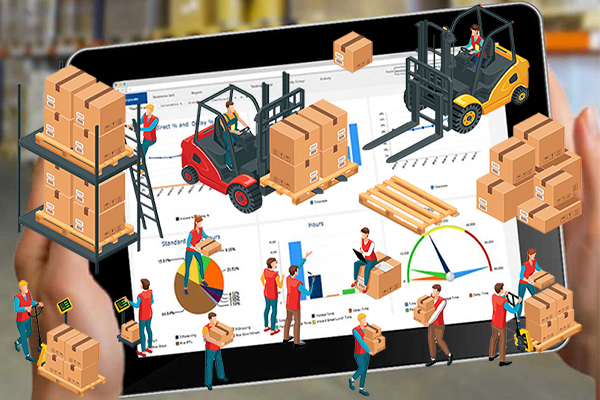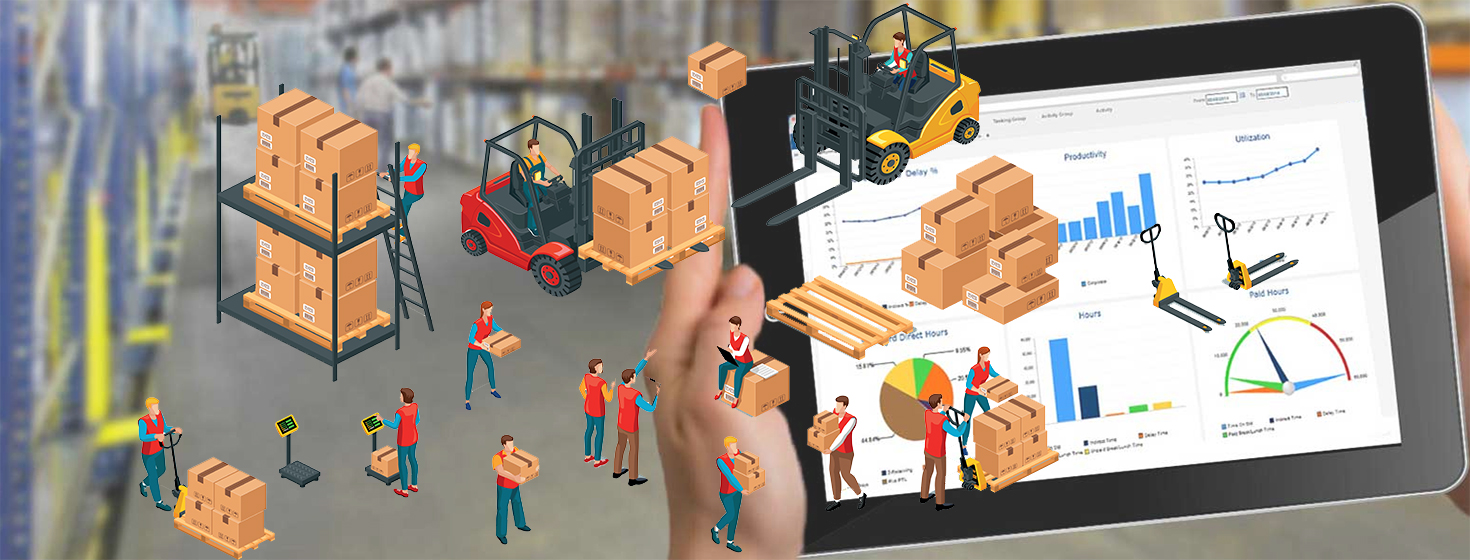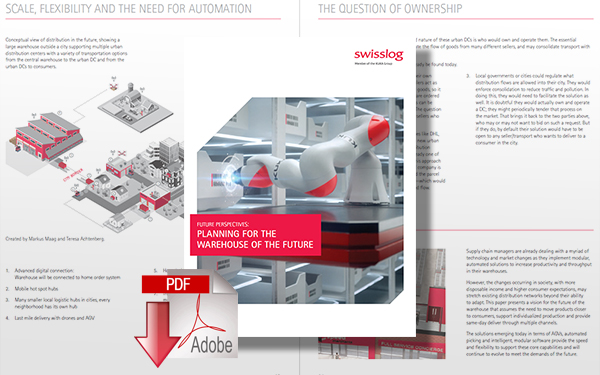The Workforce Keeps Fulfillment on Track
Even with the growing use of warehouse automation, it’s the workforce that keeps fulfillment on track.
From associates picking orders to a cart with direction from a mobile device, those on a voice-directed system, or an associate who is the “person” in a goods-to-person automation set-up, people remain essential to efficiently getting the orders out the door on time.
That makes labor management systems (LMS) solutions increasingly important, even with the move to more automation. Add in the need to keep warehouse associates motivated and retained when warehouse labor remains challenging to find, and LMS and other solutions that keep an eye on labor productivity become essential.
However, the solutions today are different than those a decade ago. They integrate with more systems, have mobile user interfaces, and use advanced analytics.
Overall, LMS today can move the needle on performance during the course of a shift, observes Jeremy Hudson, director of client services with Open Sky Group (pictured left), a consulting firm that helps companies deploy LMS.
“The key innovation we continue to see is mobility, mobility, and more mobility,” says Hudson.
“Labor-management was always intended to be real-time, in terms of putting data into the hands of supervisors, but we continue to see the push to make that information more accessible. The other trend is the gamification of labor-management, by providing real-time insights on user performance and putting that information in front of users to allow them to shift performance, potentially mid-day.”
The best way to think about LMS is as a more dynamic solution set than in the past. And, with the increasing use of automation in DCs, labor productivity monitoring for automated zones creates an area of overlap and potential integration between LMS and warehouse execution.
Mobility and Business Intelligence
LMS vendors have generally adopted web and mobile-based user interfaces, as well as user-configurable dashboards, to make information more accessible. Gamification functionality builds on that and makes current performance levels visible to individuals. LMS software can also consider factors such as distances, the weight and size of goods being handled, and other considerations such as whether special equipment must be set up, says Hudson.
“With a WMS, you may be able to see pick rate or throughput data, but with most WMS solutions, a pick is a pick, and it’s not taking into account all of the time elements that are often involved,” explains Hudson. “What a labor-management solution allows you to do is consider elements like travel distance, the equipment you’re using or need to set up, and then assess all those elements to formulate a more specific standard.”
LMS has evolved beyond its heritage as a labor tracking solution that calculates labor standards and tracks performance against those standards, says Evan Danner, CEO of TZA (pictured left), an LMS vendor.
One of the biggest changes is LMS’s richer analytics and business intelligence (BI) that allow an organization to drive additional waste out of operations that go beyond improving associate performance.
“Additionally, there has been a rapid growth of management tools, including sophisticated alerting capabilities, within the LMS that gives floor managers the real-time information they need to better manage their department.”
One use for BI, Danner explains, is to look at trend lines and project forward which areas of the business are growing the fastest, so adjustments can be made in labor forecasting. “So, if I’m a third-party logistics (3PL) provider, and I’m looking at my business with 20 customers across eight different buildings, I’m not just labor planning for the building. I can labor plan and forecast at the customer level,” says Danner.
“This data provides a 3PL organization the data to make informed decisions on service pricing strategies and margin.”
In short, LMS analytics provide insight into a range of crucial data across all facilities for supply chain managers, says Danner, like the mix of work, lost time, and cost changes by functional area or department.
Labor management software not only tracks task performance, but it can also help motivate employees, and some solutions can model and predict behaviors
“LMS is now using more sophisticated business intelligence capability to look at more than performance and utilization measures to provide deeper operational and business insights, so you can make the right adjustments,” says Danner.
Tom Stretar, vice president of technology and the labor-management practice for enVista, a consulting firm that offers LMS, agrees LMS has more analytics than in the past, looking at more than performance against engineered standards. LMS analytics, for example, can be leveraged to help understand the impact of incentives on retention.
“Labor-management solutions are really mature when it comes to functionality for managing how long should tasks take, now it’s grown beyond that to address broader human capital management concerns.”
Employee Engagement Lever
By monitoring when an associate exceeds a percentage of the engineered standard for a task, or some other measure such as units per hour, LMS can trigger incentives when a threshold is met in a way that’s a win-win.
“If you do it right, you’re paying the employee more money, but you’re getting a corresponding increase in productivity,” says Peter Schnorbach, senior director of product management with Manhattan Associates (pictured below).
“So technically, you’re getting more bang for the buck and ensuring a more competitive operation.”
Using functionality like incentive management and gamification, LMS is emerging as a means of improving employee engagement, adds Schnorbach.
This fits with the challenges of the present pandemic times where frontline workers remain hard to find and retain.
“There has been a heightened awareness around the importance of the frontline workforce and a recognition that our economy can’t operate without them,” says Schnorbach.
“In terms of labor-management, this means that while companies have always been very focused on systems that improve productivity, they’re becoming equally as focused on ways to improve employee satisfaction.”
Other LMS functions also help employee engagement. For example, says Schnorbach, LMS should be able to set up and manage small goals and rewards to motivate workers. Ideally, labor solutions should also be capable of automatically congratulating workers as they reach small goals and milestones, building on the power in mobile user interfaces.
“We’ve been able to sort of productizing so the things we used to expect supervisors to do to reinforce good work behaviors, we now can do with the labor-management product,” he adds.
Another LMS frontier in employee engagement is using advanced analytics and machine learning to spot when frontline workers are more apt to quit, says Jason Franklin, director of product management with Honeywell Intelligrated (pictured right).
With Honeywell’s LMS, machine learning technology is being used to more accurately predict employee attribution based on historic separations.
“The software considers the behaviors individuals in a facility tend to exhibit right before they quit and match it to people who may be in a similar scenario, that allows time to set up an engagement model that could help us avoid that separation and the costs involved.”
Work Execution Insights
Lucas Systems isn’t an LMS vendor, but its “Work Execution” software optimizes processes and gives supervisors tools to manage associate performance, balance work-in-process, and adjust operations.
The vendor’s work execution solution includes dashboarding and reporting on labor productivity, though the system is also a broader platform for work execution, says Justin Ritter, director of project operations with Lucas Systems (pictured below).
“Work execution functionality is about optimizing and orchestrating all the work within the four walls of a site,” says Ritter.
“We are integrating with a customer’s host system, whether that be an enterprise resource planning system or a warehouse management system (WMS), and providing a front-end for execution for the workers on the floor. Work execution guides them through their tasks. And because the system guides them through their work and records the results, we’re able to provide feedback to supervisors around productivity.”
Mobile user interfaces and frequently updated dashboards make LMS more dynamic than in the past.
Much of the value of work execution, says Ritter, is in the way it handles order releasing and batching, and assigns tasks to minimize worker travel in picking or other tasks like replenishment. The execution solution has a capability called Dynamic Work Optimization, or DWO, that addresses pick path optimization so workers have efficient travel paths, to begin with.
“The solution is both about the optimization of the work, and also the real-time feedback and tools for the supervisors to monitor and improve performance through goal setting,” Ritter says.
Lucas Systems’ work execution solution is deployed at more than 400 sites. One of these users is Baptist Health South Florida, which leverages Lucas Mobile Work Execution to handle order release, work execution, warehouse management, and picking activity at its central DC, serving a network of 10 hospitals and other sites such as clinics.
Since it was deployed a few years ago along with Lucas Systems’ voice-directed applications, productivity doubled in the main piece picking area of the DC, while pick accuracy improved and now exceeds 99%.
For the future, Lucas Systems is looking to use machine learning to dynamically calculate completion and goal times without the need to develop and manage engineered labor standards, Ritter says, which will enhance work release and execution, as well as improve workforce planning.
Automation Helper
While integration between LMS and WMS is common, says Hudson, it’s rare to have LMS integrated with a Warehouse Execution System (WES) used to manage goods-to-person (GTP) automation. The reason for potentially integrating LMS with WES, he adds, is that on its own, a WES would assume a constant pick rate in a GTP system, even when human pickers with different performance levels are involved.
“There is potential for labor-management to provide real-time insights back to a WES, and then the WES would be able to release work or batch work accordingly, or shift workaround based on that real-time labor insight,” says Hudson.
WES solutions have resource management and productivity monitoring tools built-in, looking not only at automation equipment but also the availability and performance of labor, notes Lisa Howard, director of software product strategy for Fortna (pictured right).
With Fortna’s WES, this visibility into throughput, availability, and productivity is used to inform decisions the WES makes around order release, planning, and load balancing across areas of the warehouse to create a smooth flow of work.
While some overlap exists between throughput monitoring in WES and labor performance tools in LMS, two distinct capability sets are used for different purposes. A DC operation could benefit from both types of solutions, with WES using throughput information to ensure a smooth, productive flow of work through the warehouse.
“WES has a different business goal, with WES it’s more about balancing the workload and using optimization science and intelligence within our system to optimize resource utilization as we are releasing work.”
WES solutions may feature some resource management functions to monitor issues such as whether a worker in an automated zone is logged in and ready to go, inactive or is seeing excess work start to stack up in their area. But the primary focus of WES is the overall system productivity, rather than incentives, retention, or individual performance improvement, explains Howard. “WES is focused on the end-to-end system and how to keep it flowing smoothly,” says Howard.
It is possible to integrate LMS to systems such as WES, as well as others like time and attendance or returns processing systems, says enVista’s Stretar. Care needs to be taken, however, that details like user IDs are synchronized across the systems.
Some users of Honeywell’s respective LMS and WES solutions have begun to integrate the two worlds, says Franklin, though to varying degrees. Some organizations might simply refer to LMS data to set up WES with some informed data on dwell times or expected throughput rate, while others might integrate the solutions so that LMS data can be feed data into WES on a daily basis, while a third level would be a more frequent integration, with WES taking in LMS data every 15 or 30 minutes, so the WES can make improved decisions around load balancing and order release.
“The more data points a WES has, and the more frequent those data points come in, the better decisions WES can make,” says Franklin. “The way we see it, there are still separate systems, but the combination of the two could allow you to make better decisions.”
SC24/7 Companies Quoted:
enVista | Fortna | Honeywell Intelligrated | Lucas Systems | Manhattan Associates | Open Sky Group | TZA
Related Resources
Critical Elements of Warehouse Management Systems & Labor Implementations
This white paper explores the critical elements of warehouse management systems and labor management systems implementations, from setting expectations to ensuring the final installation adds value to everyone’s day. Download Now!
Overcoming the W_S Acronym Overload
This white paper discusses the established software paradigm for warehouses and distribution centers and introduces an alternative approach. Download Now!
Planning for the Warehouse of the Future
This paper reviews the major social and technology trends that will shape the warehouse of the future, analyzes their impact, and presents a vision for how the industry can provide the speed and agility to support the expected demands of the market in 2030 through the development of hyper-local, urban distribution centers. Download Now!
More Resources on Labor Management Systems
Related Article: Expanding Warehouse Execution Systems to Encompass Wide-Ranging Distribution Center Solutions
About the Author
Follow Robotics 24/7 on Linkedin
About the Author
Follow Robotics 24/7 on Linkedin
Article topics
Email Sign Up































